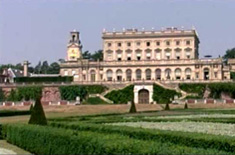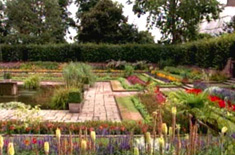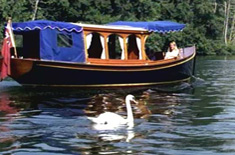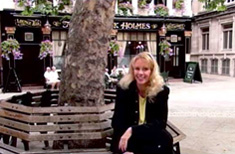Britain’s Historic Countryside
To be or not to be? That is the question. Hamlet, or was that MacBeth? I always get confused. I do know where we can find the answer, though. In the historic countryside of Britain, or is that England? Okay, England, Scotland and Wales are under Great Britain, so both are correct!
Since most people are based in London, that is England and hopefully, it will be a beautiful day to explore some great areas that are perfect for day trips outside of the crown city. Now, what comes to mind when I say English countryside? Thatched roofs, country lanes, horses, castles, the local pub, a lot of little towns and villages you may or may not know? Well, before we’re through, you’ll have seen all those things and even a castle or palace or two.
Did I say a castle? Yes, and the English country homes run from the ostentatious to quaint and practical. Luckily for us, many of them are located just a quick car or train ride from London. For a detailed explanation with transportation, there are all kinds of tours available on comfortable coaches. I like to explore on my own at my own speed, so you can take a train if you want to, but I’ll give a rental car a try!
 Not only do I get to practice driving on the left hand side of the road, but I also get to see some interesting small towns along the way. And the best part about these towns is, they all have a claim to fame from a cathedral, to a castle!
Not only do I get to practice driving on the left hand side of the road, but I also get to see some interesting small towns along the way. And the best part about these towns is, they all have a claim to fame from a cathedral, to a castle!
If you’re looking for answers to our questions or you want an attraction of Shakespearean proportions, then you have to go to Stratford-Upon-Avon, the Bard’s birthplace. A lot of the towns here are multi-named, like Stow-in the-Wald, Shipston-on-Stowers, Stratford-Upon-Avon. Well, what it means is, the second word is usually the name of the river the village stands next to, like the Wold, the Stower, or the Avon rivers. Stratford village sits right upon the river Avon, and so it goes.
But what is it that makes Stratford-Upon-Avon such a big attraction? …Hhhmmm? Well it might have something to do with that famous poet and playwright who went to school here, lodged his wife here and was born here. None other than Shakespeare, himself.
The central attraction is William Shakespeare’s house, still standing and accurately preserved. This is it, the birthplace of the man himself. He was born April 23, 1564, almost 450 years ago. He lived in this house until he was almost 18 years old. Seeing this and being here takes it out of the history book and just making it come alive. This is great! You’ll go through a very low doorway into this little house and just stand in awe at the depiction of life in the old days. The room he was born in, the child minder (a wooden seat suspended from the ceiling on a pole) in the center of the kitchen.
Astonishingly, within about seventy years of his death, the very first visitors, we know from their letters, were already coming here as a sort of place of pilgrimage. This has continued through the eighteenth and nineteenth centuries, to include visits from Thomas Jefferson, John Adams, then later, Lord Byron, Keats, Thackery, Charlie Chaplin, Sarah Bernhardt and now Laura McKenzie and you!
The rooms in the house were refurbished to resemble what they would have looked like in Shakespeare’s time. Most visitors are surprised at how bright and cheerful they are! This historic building not only commemorates Shakespeare and his writing, it also sheds some light on his father and his father’s profession.
His father was a tanner and glove maker. His workshop is still there, where the gloves would have been made, cutting out, assembling the pieces for sewing. The tanning, because he was a tanner as well, would have been done behind the property. That’s a less savory part of the business, it’s very smelly. There are baskets of wool that represent the expansion of business, as Shakespeare’s father expanded into selling wool, timber and grain.
While Shakespeare’s father was once quite the entrepreneur, today it seems that everyone is finding away to make money in Stratford-Upon-Avon. Everything here has a Shakespeare theme. The As You Like It Café, the MacBeth Bookstore, the Shakespearean… you get the idea. It’s pretty touristy, but the basis for all that tourism is real- it’s Shakespeare, his works, his plays, his life. So, if you kind of dig through all that touristy stuff to find something really special.
One of the best ways to enjoy Shakespeare is to walk through Bancroft Gardens. This is a great place to come face to face with the master or sit back and read one of his works. Ah, it was Hamlet who said the “to be or not to be?” I quoted. Walking through the village, you’ll also see Anne Hathaway’s cottage, the home of Shakespeare’s wife and their 3 children. It is the subject of many a postcard and painting, complete with thatched roof and colorful flower beds all around it.
One of my favorite things to do in Stratford doesn’t have anything to do with Shakespeare. It is so beautiful on the river here. You can come and feed the geese and the swans and the ducks. You know what? They’ll eat right out of your hand. But, when you’re on the River Avon you don’t want to just stand on the shore. Get out and do something! I’d much rather go punting. What’s punting you say? It’s a boat bedecked with pillows that is pushed along the river with a pole and paddle by someone else.
So, punting is all about being leisurely on the river. Sitting on some nice, soft cushions, close to the water and enjoying yourself. It’s very comfortable, you’ll have a great time. This is not only a relaxing ride it is also a great way to see some of the sights without the crowds. Like the theater.
There is more than one theater here, actually, there are three theaters in Stratford: two on the river side, one behind the other. The original theater from the 1930’s and the Swan Theater behind it, but there’s also a further theater, about two hundred meters down river, in which modern plays are performed. It’s very easy to get tickets, particularly because they always keep some tickets back to be sold on the day of the performance. So, even if you’re here for one day, you can pretty well be guaranteed to get a seat.

Ah, punting on the Avon… now this is the life. But you don’t have to go to Stratford to enjoy it, because people punt all along the Avon. In fact I hear Oxford is a great place for punting. But Oxford is more than just a pretty riverside town. It’s the home to thousands of British scholars. It’s also the alma mater of 13 Nobel Prize winners, several prime ministers, numerous literary icons, and royals.
The exact start date for Oxford University is unknown, but the general belief is that the school opened in the 13th century after Paris universities closed their doors to British scholars. Today Oxford has 39 federated colleges attached to it and a long and prestigious history. Plus the campuses are beautiful to boot. But it’s not all about good looks, Oxford also sees a little action! While college students are infamous for how hard they party, they still don’t know how to party like a prince.
But George IV sure did. In fact, he did most of his partying in the beach town of Brighton down on the southern coast of England, where even today, people still come to party hard. The main thing to see here is the Royal Pavilion! George’s IV’s country party pad, so to speak. It was here that the Prince Regent brought his friends and mistresses to gamble and drink, getting up to all kinds of mischief.
The exterior of the Pavilion was designed by John Nash to be an Indian style palace. Since the Pavilion resembles the Taj Mahal, I think he did a great job. While the outside is impressive, you don’t get a true feeling for the pavilion until you go inside.
Most of the rooms are decorated in a style called Chinoisery, which means that the decorations have a Chinese style, but are not actually created in the Far East. Each room has so much detail! Nash even carried out the theme in the kitchen! George IV was definitely a man with a vision.
But King George wasn’t the only one with an eye for Brighton. This town is still the hangout for Englishmen on holiday. It is a seaside resort. Oooh! If you could just smell the air! I love it at the beach. It’s the sea and the sand and the salt and waffles and cotton candy and fish and chips. Uh! It’s great! “…By the sea, by the sea, by the beautiful sea!” To really be by the sea, then there’s no better place to go than the famous, Brighton Pier. They’ve got games and food and shopping. It’s a lot of fun for the kids, and the big guys too. But if you prefer to sit back and soak in the sun and play in the sand, well, you’re kind of out of luck.
Let’s take a minute and define beach. This is not the sugar white sand you may have imagined. Here in Brighton the beach is rocks. Now how do you make a sand castle out of these? What’s that? Beaches and boardwalks are not your thing? Well then, I hope you like shopping, because Brighton has everything you could ever want, from bistros and bars to baubles and breast plates. There is an antique shopping area called The Lanes, where you still may find some authentic pieces, definitely some antique people, and it is a lovely way to spend time browsing before a pub lunch of toad-in-the-hole, scotch eggs, bubble and squeak, a Cornish pastie, or steak and kidney pie! To you Americans out there, that’s a sausage baked in batter, a hard-boiled egg in a sausage ball that is breaded and fried (served cold with mustard), leftover boiled cabbage and potato fried, ground meat, potatoes and vegetables (last night’s leftovers) baked in a pastry shell, and a pastry shell pie of steak and kidneys in a brown gravy.
But you won’t have to search all over for the must buy in Brighton… because it’s everywhere. You can’t leave here without some Brighton Rock! What is Brighton Rock you say? It’s the famous candy. It’s kind of like a big candy cane, but the name Brighton Rock is boiled all the way down the stick, so no matter how you slice it, you always see the name. Clever! Not just smart, it’s also delicious! And a great present to take home to your friends. Takes a couple days to consume it, though.
All this shopping has made me pretty hungry and while I could eat a whole bag of Brighton Rock, I think I’ll try something else here that’s also so terribly British…fish and chips.
Fish and chips have been a British tradition for decades. And being that England is surrounded by water, it’s not surprising that fish would be their national fast food. Now you will find different kinds of fish to go with your chips, there’s haddock, plaice, occasionally skate, hake and dogfish. But the traditional variety is cod.
Chips are easy to explain. They’re big French fries. Ah, but don’t forget the salt and vinegar! The fries are thick cut and greasy, the vinegar cuts the grease and the malt flavoring sets off the other flavors. Everything comes wrapped up in a newspaper cone and you eat it with your fingers. The newspaper absorbs the liquids, so you don’t get messed up. Loaded with salt, this may not be a dish for the health conscious but we’re on vacation, so it’s okay to splurge. Mmmm, it’s really good. I’d get so fat here!
Ah, I love being by the sea. Makes me want to get out on the water! Yes, I guess you could say I’m a boat lover. In fact, one of the most famous boats in England is docked at our next location, the HMS Victory! In the seaside town of Portsmouth, just down the coast from Brighton!
This historic ship was once the working residence of Lord Nelson. You know, the guy on top of Nelson’s Column in London’s Trafalgar Square? Anyway, he’s a national hero here in England. He was the British admiral that led the Royal Navy to victory against the French during the Battle of Trafalgar in 1805. Unfortunately for Lord Nelson, he was shot during this battle. But he lived long enough to know that his fleet had defeated the French. And he had in his own words, “done my duty.”
 Today you can explore the HMS Victory, and if you like ships, then boy, is Portsmouth the town for you! Besides the HMS Victory, Portsmouth is home to the HMS Warrior, the Mary Rose and two thirds of the Royal Navy’s surface ships. This historic dockyard is a truly amazing place and shows a continuous development of the navy over one millennium.
Today you can explore the HMS Victory, and if you like ships, then boy, is Portsmouth the town for you! Besides the HMS Victory, Portsmouth is home to the HMS Warrior, the Mary Rose and two thirds of the Royal Navy’s surface ships. This historic dockyard is a truly amazing place and shows a continuous development of the navy over one millennium.
If you want to see a ship that played a major role in the development of modern warships, then you’ll need to take a tour of the HMA Warrior. You can think of her as “the missing link” of ship evolution. She was the first ironclad battleship and she is both a sailing and steam powered vessel. But enough about her design, I enjoy seeing how her crew lived. It seems pretty cramped and I definitely wouldn’t want to sleep here.
But there is a place in England that I look forward to staying at every time I return and thankfully there’re no galley duties there. I usually base myself in London, and take day trips and excursions to towns and attractions outside the city, so don’t have to pack and move all the time. I know there are a lot of hotel choices in London, but I always seem to go back to the same one, the Athenaeum Hotel and Apartments, right in the heart of everything. It’s where you’re always welcomed home like family!
Every day from five o’clock they have a champagne reception in the lobby area. It’s a welcome home to the guests if they’ve been shopping or if they’ve had a hard day at work, and it’s a nice way of saying thank you for choosing the hotel. What I enjoy here is, the guests seem to mingle among each other and that doesn’t happen in other hotels. It’s like everyone is an old friend, and that is probably true, as many of the guests have been staying here for over twenty-five years. Now that’s tradition!
The Whiskey Bar in the Athenaeum is a great meeting place any day of the week, with all your favorite drinks, cocktails, and complimentary hors d’oeuvres, it is a favorite amongst the guests and Londoners, alike! And whether it’s the Wednesday cocktail party or a pre-theater meeting place, you never know who you’ll meet. When I first discovered the Athenaeum, it’s because somebody told me this was the place to see celebrities, this is the showbiz hotel. It’s always been that way, and it still continues today, I think because it’s a very discreet hotel and celebrities feel very relaxed here. If it’s a home away from home you’re searching for in London, look no further, this is it.
My favorite part of the Athenaeum Hotel is the location, right on Piccadilly Circus, right in the middle of it all. You’re in the heart of Mayfair, which is a fantastic location. If you turn left out of the hotel, and walk a few minutes, you’ll be in the heart of the theater district, and if you turn right, you’ll hit Harrod’s and Harvey Nichols department stores, which are in the fabulous shopping area of Knightsbridge. In front of the hotel, is Green Park, and just five minutes away is Buckingham Palace, so it’s an amazing location. Behind the hotel is shepherd’s market, which is a beautiful dining area, lots of little cobbled streets, very unusual.
I promised castles and I’m going to deliver on that promise with one of the most impressive castles left in England…Arundel. This is another day excursion from London, so be sure and plan enough time to see all the sights while you are here. The castle stands in the County of Norfolk, about 70 miles outside of London, in East Anglia.
Construction on this castle began in the 9th century, but most of the structure was destroyed during the English Civil War. It wasn’t until the 18th and 19th century that the castle was renovated to its original glory. Though it’s hard to believe Arundel Castle has been in the hands of the same family since 1102. The present Duke of Norfolk actually still lives there. Can you imagine owning a vast estate for nearly a millennium? And if you think the castle is impressive check out the view. Can’t you just envision the knights fighting in the courtyard! You know, when people think of medieval history, they think of knights and armor and damsels in distress. It was a lot more than that.
Life was tough…winters were cold…and without today’s modern conveniences, even the wealthy didn’t have it that easy. Most people didn’t live like lords and kings. So it’s hard to imagine how the commoners survived through the centuries. One place to get an idea of what life was like even two hundred years ago, is just down the road from the castle, at the Weald & Downland Open Air Museum. For a city girl like me to get out in the country, and to see what life was like back in the 17th or 18th century, that’s really special. And, the fact that these buildings are real, and not reproductions, it really brings the history to life. You mainly get to see old buildings at the museum. It was set up to rescue old buildings that were going to be destroyed. They were taken down and moved to the grounds and there are about 45 of them now to see.
But wait until you see this most beautiful place. It’s gorgeous right down to the landscape, quintessential English landscape, so you can just walk around and enjoy the historic buildings, the landscape background. Just like the old days, it takes a lot of walking to get around and see everything, but it’s worth it, and don’t miss looking inside!
One house that you have to see is called “Bay Leaf House.” Not only is it furnished, it’s totally authentic, with bedrooms and everything. This place would have been a fairly wealthy person’s home because of the size. High ceilings, incredible! Normally, the kitchens would be detached from the house because of fire, but this house had a fire pit right in the middle. You’ll see what they would call a “curfew pot,” a domed lid, next to the fire. They put this on at the end of the day to cover up the fire safety reasons, basically.
 Now it must have been really cold in there—no curtains, no glass. But the windows were shuttered, so when it got too windy, they could shut them to keep the hill out. You’ll see the bedrooms and climb steep chairs to see a child’s room. In the master bedroom you’ll see an authentic bed of the time. The bed is made of a straw tack mattress, stuffed with straw. They had cotton sheet, a couple of coarse wool blankets, and pillows were stuffed with sheep’s wool. Now, the open air museum is more than just buildings. It showcases many professions that commoners would have held in the 17th and 18th centuries. From farming to milling and blacksmithing, and there are demonstrations of each going on throughout the day. One of the most interesting things about these demonstrations, is they try to keep it as historically accurate as possible. They brought in a real forge from the village of Horsham, which was built over 150 years ago.
Now it must have been really cold in there—no curtains, no glass. But the windows were shuttered, so when it got too windy, they could shut them to keep the hill out. You’ll see the bedrooms and climb steep chairs to see a child’s room. In the master bedroom you’ll see an authentic bed of the time. The bed is made of a straw tack mattress, stuffed with straw. They had cotton sheet, a couple of coarse wool blankets, and pillows were stuffed with sheep’s wool. Now, the open air museum is more than just buildings. It showcases many professions that commoners would have held in the 17th and 18th centuries. From farming to milling and blacksmithing, and there are demonstrations of each going on throughout the day. One of the most interesting things about these demonstrations, is they try to keep it as historically accurate as possible. They brought in a real forge from the village of Horsham, which was built over 150 years ago.
The kids can get into the act for some of the demonstrations, and cooking is the easiest for everyone but me! They use old Tudor recipes to make little cakes and pies using kitchen utensils and the recipes from the late 1500’s.
William Shakespeare once wrote, “we’ll teach you to drink deep ere you depart.” I don’t know if he was referring to his home in the historic countryside of southeast England or of his favorite pub, but clearly this sentiment stills rings true today. From the castles to the medieval cottages, you’ll experience nothing but warmth and hospitality in the historic countryside of England. No truer words bespoke the Bard! Caribbean are not a myth.
